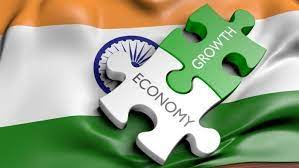


As expected, the RBI Monetary Policy Committee (MPC) has kept the repo rate unchanged at 6.50 per cent on the 8th June 2023 monetary policy, as inflation (CPI) has shown softening trend. The policy has worked in lag effect, nonetheless it is required to monitor whether the Indian economy is approaching towards a “durable disinflation era” i.e. inflation should reduce on sustained basis, then only the question of rate cut would arise, until then we can expect the policy rate as well as stance to be the same. The Indian economy is going through a “Goldilocks moment” with a reasonably high growth rate and moderate inflation (within the tolerance zone). India’s GDP has grown at 6.1% during the Jan-March’2023 (Q42022-23), whereas the growth in real GDP during 2022-23 is estimated at 7.2 per cent as compared to 9.1 per cent in 2021-22. It is important to recall in this context that, IMF in its report (30 Jan’23) has highlighted that “India remains a bright spot. Together with China, it will account for half of global growth this year, versus just a tenth for the US and euro area combined.” India’s manufacturing PMI is performing exceptionally well, recording consecutive months of strong expansion Other large economies are witnessing contraction in manufacturing activity China’s growth is losing steam, as indicated by the contraction in April. Further, India jumps six places in World Bank’s Logistics Performance Index. Government is focused on improving transport infrastructure with logistics accounting for 33% share of National Infrastructure Pipeline. Certain high-frequency economic indicators have shown that the Indian economy is showing rebound, e.g., E-way bill volumes and toll collections remained bright, scaling new highs in March 2023. However, there is a decline to 8.44 crore in April’23 compared to 9.09 crore in March’23, though compared to April’22 (7.52 crore), it is much higher. Retail sales of vehicles, (as proxied by vehicle registrations), recorded a four-month high in March’23 due to increases in vehicles’ registrations. Two-wheeler sales have increased by 7.7 per cent y-o-y, with the electric vehicle (EV) segment recording highest ever sales at 1.4 lakhs in March’23. Major global semiconductor companies have evinced interest in India’s ambitious semiconductor programme and are likely to formally express interest soon that will likely widen the field in terms of contenders for more than $10 billion in federal and state subsidies, apart from other benefits, that India has announced to attract semiconductor manufacturing.
EL Nino: An Emerging Threat
According to news reports, El Nino is likely to yield extreme weather later this year, from tropical cyclones spinning toward vulnerable Pacific islands to heavy rainfall in South America to drought in Australia. The return of the EL Nino is a matter of concern after three years of the La Nina climate pattern. The last time an El Nino was in place in 2016 when the world saw its warmest year on record. Coupled with warming from climate change, 2023 or 2024 could reach new highs. El Nino is a natural climate phenomenon marked by warmer-than-average sea surface temperatures in the central and eastern Pacific Ocean near the equator, which occurs on average every 2-7 years. According to the National Oceanic and Atmospheric Administration (NOAA), U.S. Department of Commerce, the El Nino is expected to be moderate-to-strong by late fall/early winter. Despite the forecast by the India Meteorological Department (IMD) about a normal south-west monsoon, which is likely to augur well for kharif crops, uncertainties remain on the spatial and temporal distribution of monsoon and on the interplay between El Nino and the Indian Ocean Dipole (IOD). Geopolitical tensions; uncertainties around the monsoon and international commodity prices, especially sugar, rice and crude oil; and volatility in global financial markets pose upside risks to inflation.
The surplus liquidity will sustain the stance for a while
Since the third week of May’23, the decline in currency in circulation and pick-up in government spending have expanded the system liquidity. This has got further augmented due to the Reserve Bank’s market operations and the deposit of ₹2,000 banknotes in banks. However, the VRRR auction got some tepid response, as most of the banks thought safe to park via MSF, which is itself depicted as “prevalence of surplus liquidity amidst higher recourse to the marginal standing facility (MSF) by some banks suggests skewed liquidity distribution within the banking system.” On 8 June 2023 the weighted average call money rate remained at 6.43% lower than the repo rate and MSF, thus supporting some surplus liquidity and withdrawal of accommodation stance.
According to the RBI’s survey, inflation expectations of households for three months to one year ahead horizon have moderated by 60 to 70 basis points since September 2022, which provides scope for the RBI to keep policy rate unchanged. Headline inflation still remains above the target and being within the tolerance band is not enough since the goal of the RBI is to achieve the target of 4.0 per cent, going forward.
The Concluding Remarks
Though higher economic growth and lower inflation is posing a “Goldilocks moment” for the Indian economy, looming threats from the El Nino impact and global uncertainty can pose certain stress. In the 8th June 2023 RBI monetary policy, the real GDP growth for 2023-24 is projected at 6.5 per cent with Q1:2023-24 at 8.0 per cent; Q2 at 6.5 per cent; Q3 at 6.0 per cent; and Q4 at 5.7 per cent, with risks evenly balanced, which are fair estimates, but considering global headwinds, the growth can be slightly on the lower side.
Vipin Malik is chairman & Mentor of Infomerics Ratings. Sankhanath Bandyopadhyay is an economist at Infomerics Ratings.